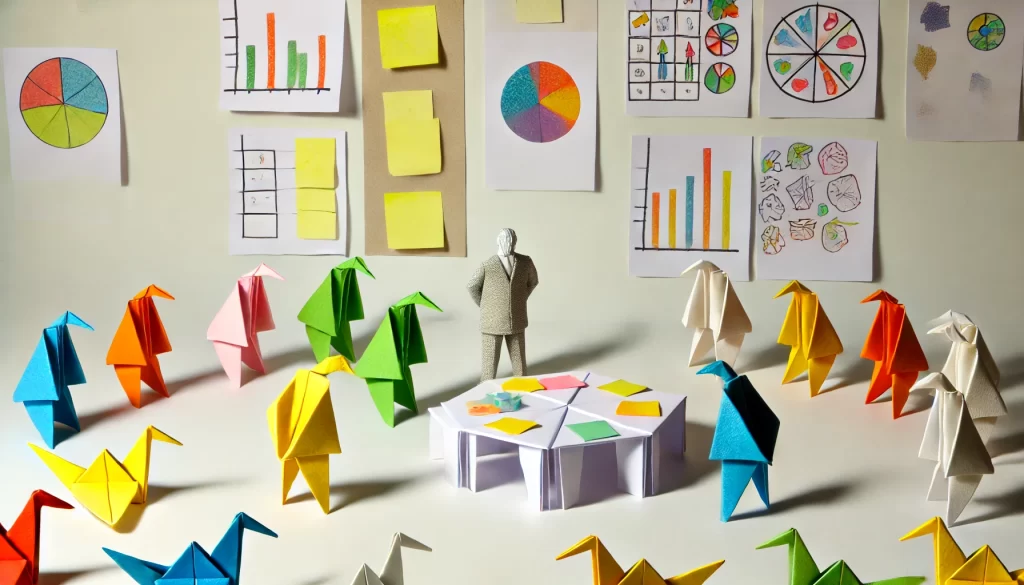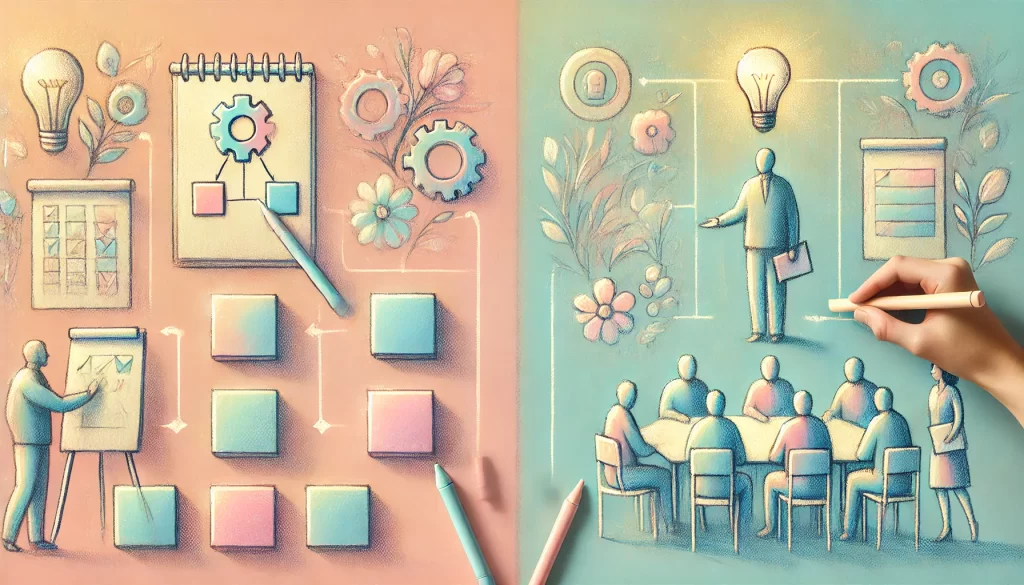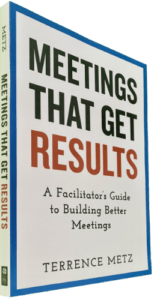1. Understand the Meeting Context and Participants
You will better understand the meeting’s purpose, the participants involved, and the specific dynamics at play by conversing with participants in advance. Learn their perspective and more about them:
- Deliverables: Secure their definition of what the meeting needs to achieve. What does DONE look like? The nature of the deliverables dictates the type of meeting approach.
- Participants: More fully understand the personalities, cultural backgrounds, and work styles of your participants. Knowing who is in the session helps tailor communication and optimize the tools you use.
- Organizational Culture: Familiarize yourself with the organizational and team cultures. Some teams are more hierarchical, while others value consensus and collaboration. Adapt your approach to align with these norms while guiding the group toward acceptable deliverables.
2. Establish Clear Deliverables and Ground Rules
Always start with the “end in mind.” To balance alignment and creativity, ensure everyone knows the boundaries within which they can freely operate. This means controlling the structure and ground rules upfront:
- Agenda and Deliverable: Share a clear agenda that outlines the purpose of the meeting and what success looks like. If everyone understands the deliverable, alignment becomes easier.
- Ground Rules: Define ground rules that promote respect, participation, and open communication. For example, encourage active listening and interrupt the interrupters, creating a safe space for creative ideas.
- Flexibility in Process: Let participants know that creativity and divergent thinking are welcomed, especially when listing ideas in brainstorming and problem-solving sessions.
3. Use Adaptive Techniques when Facilitating Business Meetings
Being adaptive means using facilitation methods that suit the flow of the conversation and the needs of the participants in real time. A combination of techniques can help foster creativity while ensuring alignment:
- Divergence and Convergence: Start with divergent techniques (such as brainstorming or mind mapping) to encourage free-flowing ideas. Then, have your analysis method pre-determined. For example, if prioritizing are you going to use PowerBalls, Decision-Matrix, Perceptual Map, etc? The tools help the team to deselect, narrow the focus, and align on the best options.
- Check for Alignment: Consistently summarize key points to ensure everyone will support what has been built. Their support is implied, even if it is not their favorite.
- Breakout Discussions: Breakout discussions and smaller group exercises foster creativity by allowing participants to explore ideas deeply before aligning in a common direction.
- Use Structured Innovation Tools: Techniques like the “Six Thinking Hats,” Changing Perspectives, and SCAMPER foster creative thinking within a structured framework. These tools allow creative exploration while keeping focus on the meeting’s deliverable.
4. Be Attentive to Group Dynamics
Adapt to the energy and flow of the meeting by guiding the group dynamics:
- Facilitate Participation: Ensure that everyone contributes by enabling quieter participants and managing dominant voices. A tool such as the “round robin” technique provides each participant an opportunity to speak. Your active listening skills ensure that they are heard.
- Manage Conflict Constructively: When disagreements arise, frame them as opportunities for learning. “Make their thinking visible” allows participants to explore divergent opinions without derailing the meeting.
- Use Your Intuition: Be sensitive to body language, tone, and energy levels. If the group seems fatigued or disengaged, introduce a quick energizer or break. If creativity is dwindling, inject a fresh exercise to spark new thinking.
5. Encourage Psychological Safety
In addition to physical safety (e.g., fire exits) ensure psychological safety. Participants need to feel comfortable sharing ideas without fear of judgment or reprisal:
- Encourage Open Dialogue: Let participants know that all ideas are welcome, especially unconventional ones. Reiterate that no idea is too “out there” and that all contributions will be treated with respect.
- Create a Judgment-Free Zone: Use techniques like “yes, and” (from improvisational theater) that build on ideas rather than shutting them down with “yes, but”. Integral thinking helps foster creativity while maintaining a sense of progress toward alignment.
6. Balance Structure and Flexibility
Striking the right balance between structure and flexibility is key to ensuring alignment without stifling creativity. Therefore, consider:
- Guided Freedom: Provide participants with structured prompts or exercises that guide creativity toward the deliverables. For example, use targeted questions to steer ideation within specific constraints (e.g., “How might we solve this problem with zero additional budget?”).
- Rhetorical Control: Use open-ended questions that allow for a range of responses such as “To what extent _______ ? and “What is the unit of measurement of _______ ?”
7. Encourage Post-Meeting Reflection and Follow-Up
Your meeting’s impact doesn’t end when the participants leave the room. Encouraging post-meeting reflection to ensure ownership and accountability:
- Recap Key Decisions and Action Items: At the end of the meeting, clearly summarize decisions made, and assign next steps with due dates to foster accountability.
- Communications: After each session get the group to agree on what they will others they accomplished. You want to ensure that everyone sounds like they were in the same meeting together!
- Continuous Improvement: After each meeting, obtain feedback on what went well and what could be improved. Have participants assess the effectiveness of the meeting and the facilitator. Use an anonymous method to secure solid, personal criticism. Use this feedback to adjust your style and technique for future meetings.
8. Foster a Culture of Alignment and Innovation
Ultimately, facilitating meetings that balance alignment and creativity is easier when it’s part of the broader organizational culture. Encourage leaders to:
- Promote Autonomy and Mastery: When participants feel empowered to take ownership of their contributions, creativity flourishes. Aligning on shared goals helps foster both autonomy and cohesion.
- Model Collaborative Leadership: Leaders should set an example by promoting collaboration, open dialogue, and respect for diverse perspectives. When these behaviors are encouraged, meetings naturally become more aligned and innovative.
_____
Don’t ruin your career by hosting bad meetings. Sign up for a workshop or send this to someone who should. MGRUSH workshops focus on meeting design and practice. Each person practices tools and methods daily during the week. While some call this immersion, we call it the road that yields high-value facilitation skills.
Our workshops also provide a superb way to earn up to 40 SEUs from the Scrum Alliance, 40 CDUs from IIBA, 40 Continuous Learning Points (CLPs) based on Federal Acquisition Certification Continuous Professional Learning Requirements using Training and Education activities, 40 Professional Development Units (PDUs) from SAVE International, as well as 4.0 CEUs for other professions. (See workshop and Reference Manual descriptions for details.)
Want a free 10-minute break timer? Sign up for our once-monthly newsletter HERE and receive a free timer along with four other of our favorite facilitation tools.
Go to the Facilitation Training Store to access proven, in-house resources, including full agendas, break timers, forms, and templates. Also, take a moment to SHARE this article with others.
To Help You Unlock Your Facilitation Potential: Experience Results-Driven Training for Maximum Impact
#facilitationtraining #meeting design
______
With Bookmarks no longer a feature in WordPress, we need to append the following for your benefit and reference






